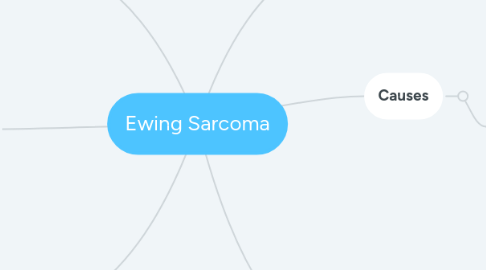
1. Symptoms
1.1. Pain, swelling, or tenderness near affected area
1.2. Unintentional weight loss
1.3. Increased Fatigue
1.4. Fever
1.5. Bone Pain
1.6. Abnormal lesions
2. General risk factors
2.1. Most common in people of ages 10-20
2.2. Affects males slightly more frequently than females
2.3. More common in white people than other ethnic groups
3. Diagnosis
3.1. Needle Biopsy
3.1.1. Removes tissue with a needle
3.2. Incisional Biopsy
3.2.1. Removes tissue by making an incision of the skin
3.3. Radiographic Images
3.3.1. On MRI, sarcoma appears opaque
3.3.2. Shows translucent bone on x-ray/CT/PET scan
3.4. Blood test
4. Concept
4.1. A rare type of cancer that most often occurs in and around of bones
5. Causes
5.1. The etiology of Ewing sarcoma is unclear at this time, but there are some speculated causes
5.1.1. DNA changes often involving the alteration of EWSR1
5.1.2. Exposure to virus and chemicals
5.1.3. Chromosome rearrangement between chromosomes #11 and #22
6. Treatment
6.1. Radiation Therapy
6.1.1. High-energy X-rays are used to destroy cancer cells or prevent them from growing
6.2. Chemotherapy
6.2.1. Uses medications to disrupt cell formation cancerous. Kills all fast-growing cells
6.3. Surgery
6.3.1. Surgical removal of cancer cells/tumor
6.4. Immunotherapy
6.4.1. TESTING DRUG: Crizotinib
6.4.1.1. an anti-cancer drug acting as an ALK (anaplastic lymphoma kinase) inhibitor
6.4.1.1.1. Currently in clinical trial for this specific cancer
6.4.1.2. PREDICTION: This drug will stop the growth of tumor cells by blocking the ALK protein from working
6.4.2. Treatment improving the immune system's natural ability to fight the disease

